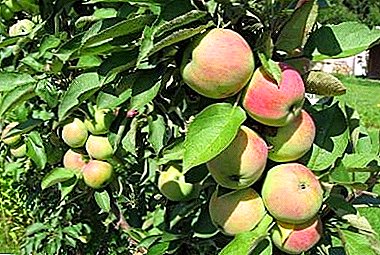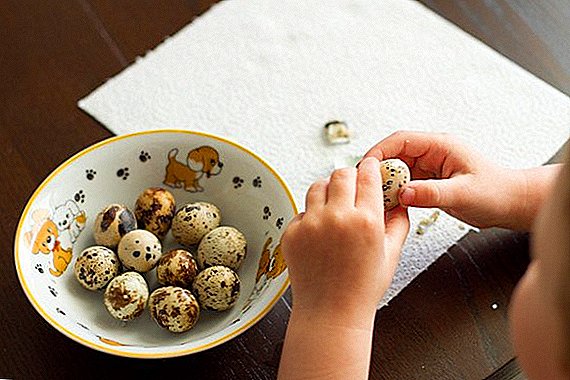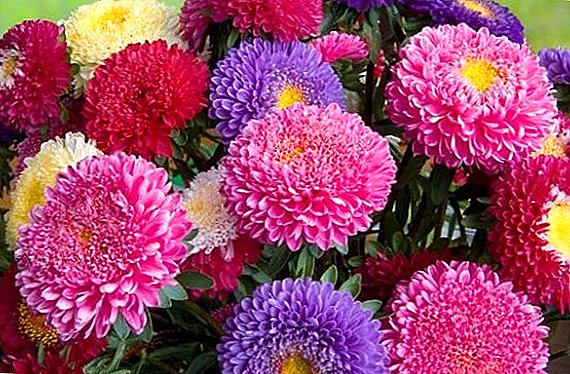
Orchid - one of the most beautiful and spectacular plants in the home flower garden. Under the conditions of care, these capricious exotic beauties delight the owners for many years. But, like many other home flowers, they can get sick from time to time. One of the most common and unpleasant problems for orchid lovers is the appearance of mold on the plant or substrate in which it is planted. Why it appears, for what reason the roots and leaves of the plant grow moldy, consider in the article.
What is it and how does it look?
Mold is a fungus that often affects indoor plants, and it looks like a shaggy coating that forms on the leaves, stalk and roots. It spreads and multiplies with the help of spores, which are extremely tenacious. Brought into the house once, the spores of the fungus can infect themselves with the wrong care flower whole.
What parts of the flower is formed?
If there are no favorable conditions, the spores of the fungus are in a "dormant" state and may not manifest themselves for many months, but as soon as the environment allows, they begin to actively proliferate. Mold can affect almost all parts of an orchid.sprawling in the voids between the bark, on the surface of the substrate, affecting the root system and the stem of the plant.
What can white bloom come from?
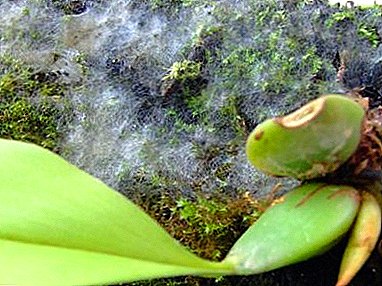 The main factor for the active spread of fungi on the orchid is too high air humidity and over-intensive spraying. For some types of orchids, such as phalaenopsis, foliar irrigation is contraindicated at all. For many other species, spraying is shown only to the root system.
The main factor for the active spread of fungi on the orchid is too high air humidity and over-intensive spraying. For some types of orchids, such as phalaenopsis, foliar irrigation is contraindicated at all. For many other species, spraying is shown only to the root system.- The second factor is very intense watering. If there are not only signs of the flower being damaged by a fungus, but also the rotting of the roots or the stems themselves have begun, then it is necessary to limit the number of waterings.
Watering an orchid is necessary only when the entire substrate is dry. Watering is done by immersing the pot in water for about 30 minutes.
- The third factor is too cold or too hard water. Watering an orchid is preferably bottled or rainwater, allowing it to pre-settle. Water should be at room temperature.
- The fourth factor is stagnant moisture in the core or leaf axils. To avoid this - after spraying and watering, be sure to remove water from the sinuses of the leaves or from the core of the outlet.
- The fifth factor is too high room temperaturewhere the flower lives. If the heat is combined with high humidity - the fungus on the orchid does not take long to wait.
- The sixth factor is dead leaves and flowers not cleaned in time. From them, the fungus can infect the soil first, and then the entire plant as a whole.
What are the consequences for a fungal plant?
In its early stages, mold is easily removed from both the leaves and the stems of the orchid. If you do not fight it, the fungus will gradually spread over the whole plant, the flower will begin to ache, the roots will dry up and eventually the orchid will die. If the plant is severely affected by mold, it is better to dispose of it.so as not to infect the rest of the flowers in the house.
How to get rid of the fungus?
In the axils of the leaves
 There are two types of mold on the leaves of orchids - white and black. White mold is easier to fight. You need a teaspoon of vitriol and dilute in 2 liters of water and the resulting solution to wipe the leaves. The activated carbon fights well with the fungus - a pill can be crushed and powder the leaves at the sites of damage.
There are two types of mold on the leaves of orchids - white and black. White mold is easier to fight. You need a teaspoon of vitriol and dilute in 2 liters of water and the resulting solution to wipe the leaves. The activated carbon fights well with the fungus - a pill can be crushed and powder the leaves at the sites of damage.
Black mold is almost impossible to cure.therefore, the diseased leaves are cut, disposed of, and the cut is rubbed with a solution of vitriol.
On the roots
Worse, if the fungus struck not only the leaves, but also the root of the orchid, since the mold destroys its shell, extremely weakening the plant.
- The orchid must be removed from the substrate, very thoroughly rinse the root, paying particular attention to the affected areas in warm water (at a temperature of 30-35 degrees).
- For 15 minutes, soak the roots and stem of the plant in a very weak solution of the fungicide (for example, in 1/4 or 1/6 of the concentration indicated on the package).
Important! If you make the solution of the fungicide too concentrated, it can lead to the burn of the plant and its further death.
What if a potted substrate is affected?
If the soil is affected by a fungus, it is best to dispose of it.
- Before changing the flower to it, the substrate should be soaked in boiling water for at least 15 minutes, dried and only then filled in the pot in which the orchid will grow.
- 3 crushed tablets of activated carbon, wood bark or some sifted ash should be added to the substrate.
- After changing the soil, the orchid does not need to be watered for at least 3 days.
- It is also advisable to place the flower in a well-lit, dry place.
At the initial stage of mold development, if it struck only the top layer of the substrate, areas with visible fungus should be removed, the soil should be loosened thoroughly and dried thoroughly, adding also activated charcoal or ash to it.
We offer to watch a video about mold in the substrate:
How to treat if the whole plant is sick?
If the flower is completely affected by the fungus, it will be extremely difficult to save it.
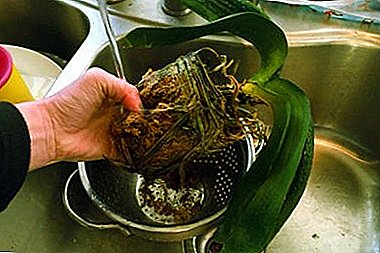 First of all, it is necessary to remove the orchid from the old soil, rinse the roots in warm water, removing the rotted or dried areas.
First of all, it is necessary to remove the orchid from the old soil, rinse the roots in warm water, removing the rotted or dried areas.- Wipe or spray the leaves and the stem of the solution of vitriol, cut off the badly damaged leaves.
- Replant the flower in a new, pre-disinfected soil and rearrange the orchid in a well-lit place.
- Do not water the plant for at least five days.
What not to do?
For treating an orchid for mold, it is recommended to relocate it to a well-lit area., but do not forget that prolonged exposure to direct sunlight, especially in summer, can lead to thermal burn of a tender flower.
When using a solution of vitriol or fungicide, their high concentration should be avoided - this can cause a chemical burn of the plant.
Do not immediately cut off all the leaves and roots affected by mold, as this will lead to a weakening of the flower. Most often it will be enough to wash them and wipe or spray the plant with copper sulfate solution.
Prevention
The best prevention of the appearance of fungal diseases is the careful observance of the rules of plant care and hygiene. The earlier the fungus is detected, the easier and faster it will be to fight it. Especially important here are the following preventive measures:
- Proper feeding:
To fertilize orchids is necessary only with specialized fertilizers, marked “For orchids” on the package. Conventional fertilizers for indoor plants are designed for use in ordinary land.
When used in bark-based orchid substrates, most salts accumulate in the substrate itself, creating an unfavorable environment for the root system. Especially neat is the attitude to the application of nitrogen fertilizers, as overdosing weakens the immune system of the plant and makes it vulnerable to mold.
 Correct watering:
Correct watering:Orchids can only be watered with moderately warm water and only when the substrate in which they grow will completely dry out.
- Regular airing:
Daily access of fresh air to the room where orchids are kept will be an excellent prevention of fungal diseases.
- Sufficient lighting:
The fungus loves dampness and darkness. In winter, when natural lighting is disturbed, the fungus appears on orchids especially often. For additional illumination of orchids, you can use lamps of artificial light.
- Regular control:
Regularly inspect the orchid for pests, diseases and mold. At the initial stage of the disease to cope with it is not difficult.
Thus, with the right care and timely detection of the disease, treating the orchid for mold is not a big deal. The main thing is to prevent severe damage to the plant by regularly examining the orchid for the presence of fungus and other diseases, and to begin treatment at the very initial stages.


 The main factor for the active spread of fungi on the orchid is too high air humidity and over-intensive spraying. For some types of orchids, such as phalaenopsis, foliar irrigation is contraindicated at all. For many other species, spraying is shown only to the root system.
The main factor for the active spread of fungi on the orchid is too high air humidity and over-intensive spraying. For some types of orchids, such as phalaenopsis, foliar irrigation is contraindicated at all. For many other species, spraying is shown only to the root system. First of all, it is necessary to remove the orchid from the old soil, rinse the roots in warm water, removing the rotted or dried areas.
First of all, it is necessary to remove the orchid from the old soil, rinse the roots in warm water, removing the rotted or dried areas. Correct watering:
Correct watering:

